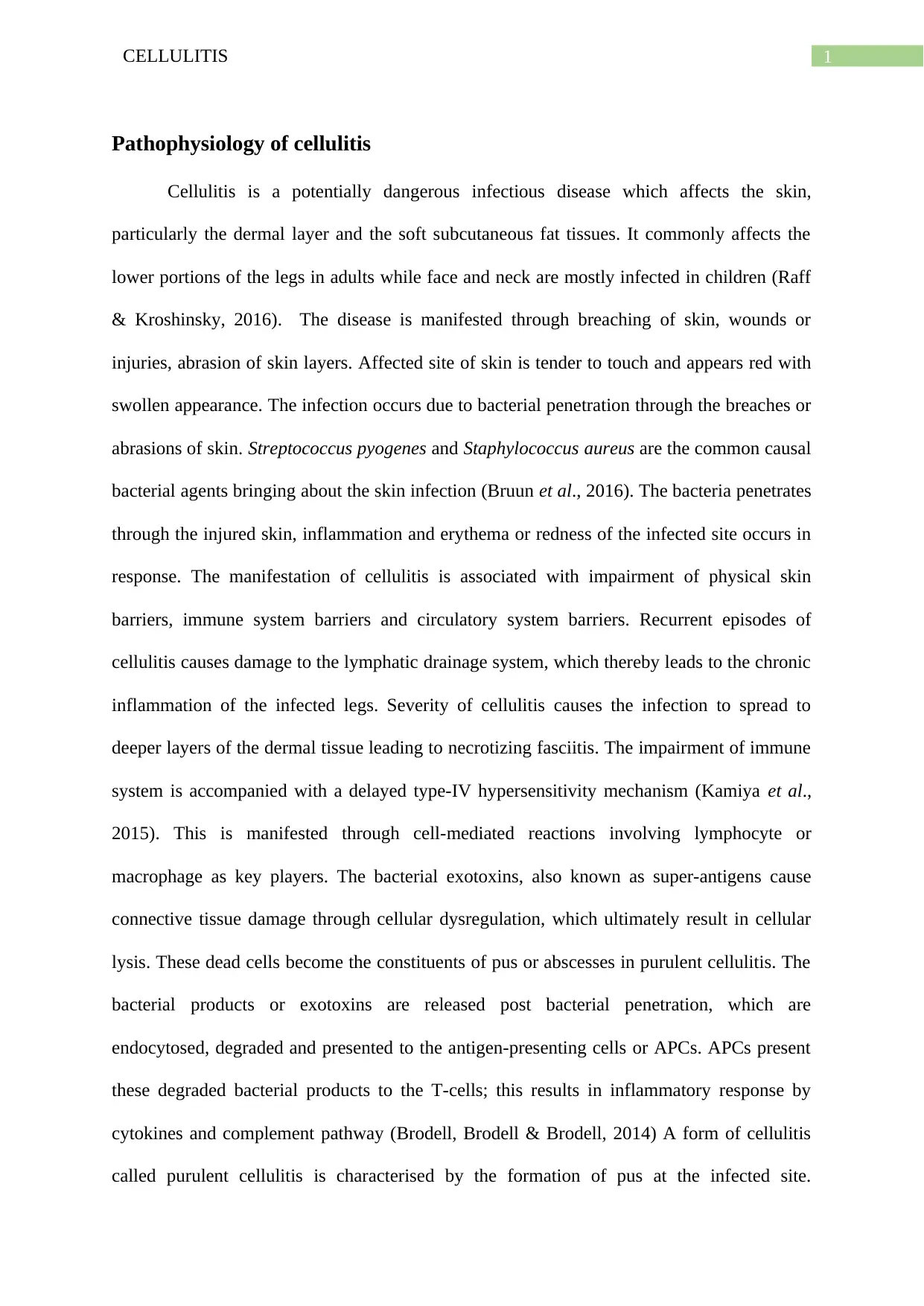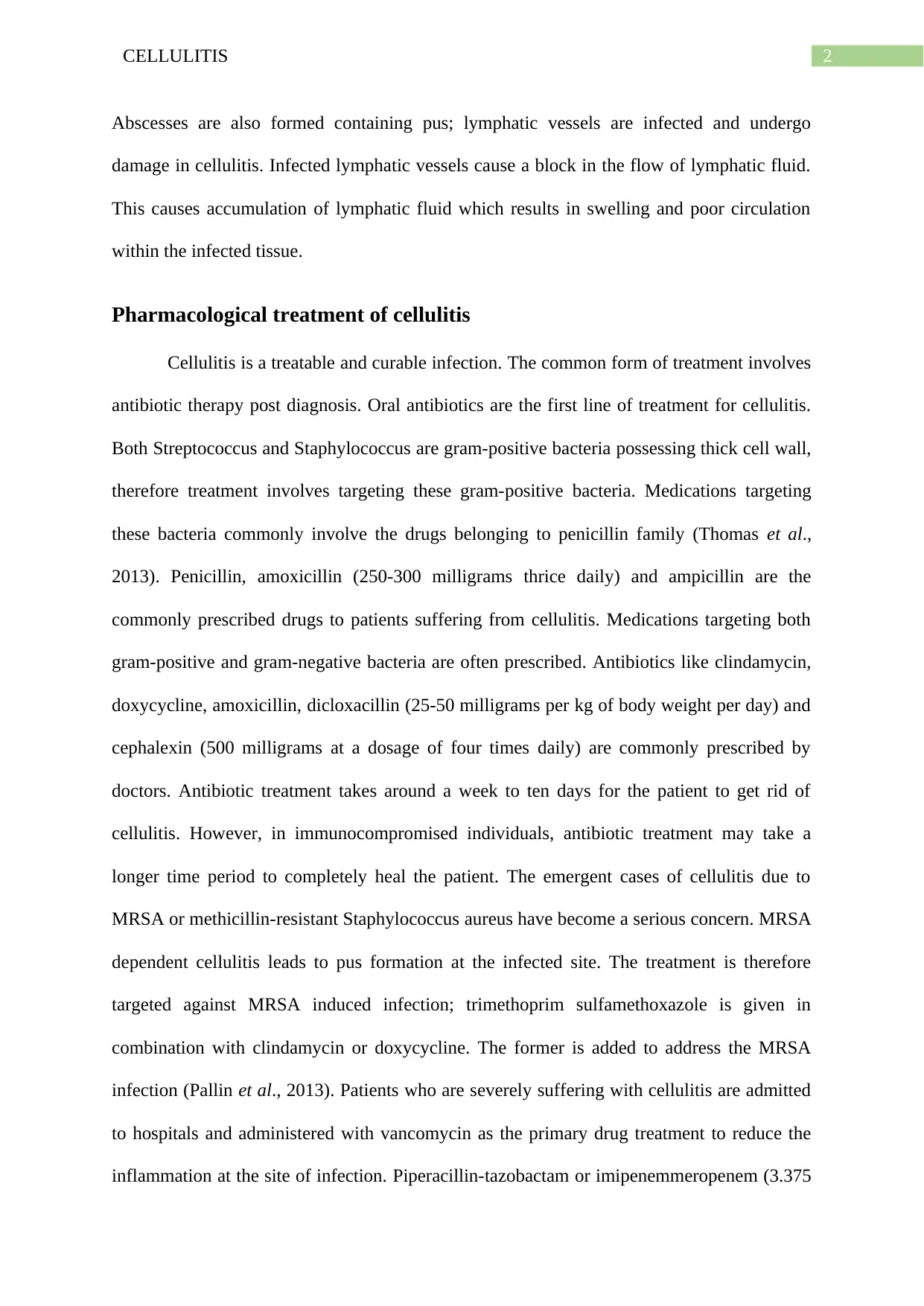Cellulitis: Pathophysiology, Treatment, and Care Plan
VerifiedAdded on 2023/04/21
|7
|1683
|83
Report
AI Summary
This report provides a comprehensive overview of cellulitis, a bacterial infection affecting the skin and subcutaneous tissues. It details the pathophysiology of the disease, including the roles of Streptococcus pyogenes and Staphylococcus aureus, the breaching of skin barriers, and the subsequent inflammatory response. The report discusses various pharmacological treatments, including oral and intravenous antibiotics like penicillin, amoxicillin, clindamycin, and vancomycin, tailored to combat different forms of cellulitis, including MRSA-related infections. Furthermore, it outlines a care plan emphasizing rest, elevation of the affected area, pain management, and the importance of personal hygiene to prevent recurrence. The report also addresses the management of purulent cellulitis, which requires more aggressive treatment strategies beyond standard antibiotic therapies. Desklib offers a range of resources, including past papers and solved assignments, to aid students in understanding and managing cellulitis and other related topics.

Running head: CELLULITIS
Cellulitis
Name of student:
Name of university:
Author Note:
Cellulitis
Name of student:
Name of university:
Author Note:
Paraphrase This Document
Need a fresh take? Get an instant paraphrase of this document with our AI Paraphraser

1CELLULITIS
Pathophysiology of cellulitis
Cellulitis is a potentially dangerous infectious disease which affects the skin,
particularly the dermal layer and the soft subcutaneous fat tissues. It commonly affects the
lower portions of the legs in adults while face and neck are mostly infected in children (Raff
& Kroshinsky, 2016). The disease is manifested through breaching of skin, wounds or
injuries, abrasion of skin layers. Affected site of skin is tender to touch and appears red with
swollen appearance. The infection occurs due to bacterial penetration through the breaches or
abrasions of skin. Streptococcus pyogenes and Staphylococcus aureus are the common causal
bacterial agents bringing about the skin infection (Bruun et al., 2016). The bacteria penetrates
through the injured skin, inflammation and erythema or redness of the infected site occurs in
response. The manifestation of cellulitis is associated with impairment of physical skin
barriers, immune system barriers and circulatory system barriers. Recurrent episodes of
cellulitis causes damage to the lymphatic drainage system, which thereby leads to the chronic
inflammation of the infected legs. Severity of cellulitis causes the infection to spread to
deeper layers of the dermal tissue leading to necrotizing fasciitis. The impairment of immune
system is accompanied with a delayed type-IV hypersensitivity mechanism (Kamiya et al.,
2015). This is manifested through cell-mediated reactions involving lymphocyte or
macrophage as key players. The bacterial exotoxins, also known as super-antigens cause
connective tissue damage through cellular dysregulation, which ultimately result in cellular
lysis. These dead cells become the constituents of pus or abscesses in purulent cellulitis. The
bacterial products or exotoxins are released post bacterial penetration, which are
endocytosed, degraded and presented to the antigen-presenting cells or APCs. APCs present
these degraded bacterial products to the T-cells; this results in inflammatory response by
cytokines and complement pathway (Brodell, Brodell & Brodell, 2014) A form of cellulitis
called purulent cellulitis is characterised by the formation of pus at the infected site.
Pathophysiology of cellulitis
Cellulitis is a potentially dangerous infectious disease which affects the skin,
particularly the dermal layer and the soft subcutaneous fat tissues. It commonly affects the
lower portions of the legs in adults while face and neck are mostly infected in children (Raff
& Kroshinsky, 2016). The disease is manifested through breaching of skin, wounds or
injuries, abrasion of skin layers. Affected site of skin is tender to touch and appears red with
swollen appearance. The infection occurs due to bacterial penetration through the breaches or
abrasions of skin. Streptococcus pyogenes and Staphylococcus aureus are the common causal
bacterial agents bringing about the skin infection (Bruun et al., 2016). The bacteria penetrates
through the injured skin, inflammation and erythema or redness of the infected site occurs in
response. The manifestation of cellulitis is associated with impairment of physical skin
barriers, immune system barriers and circulatory system barriers. Recurrent episodes of
cellulitis causes damage to the lymphatic drainage system, which thereby leads to the chronic
inflammation of the infected legs. Severity of cellulitis causes the infection to spread to
deeper layers of the dermal tissue leading to necrotizing fasciitis. The impairment of immune
system is accompanied with a delayed type-IV hypersensitivity mechanism (Kamiya et al.,
2015). This is manifested through cell-mediated reactions involving lymphocyte or
macrophage as key players. The bacterial exotoxins, also known as super-antigens cause
connective tissue damage through cellular dysregulation, which ultimately result in cellular
lysis. These dead cells become the constituents of pus or abscesses in purulent cellulitis. The
bacterial products or exotoxins are released post bacterial penetration, which are
endocytosed, degraded and presented to the antigen-presenting cells or APCs. APCs present
these degraded bacterial products to the T-cells; this results in inflammatory response by
cytokines and complement pathway (Brodell, Brodell & Brodell, 2014) A form of cellulitis
called purulent cellulitis is characterised by the formation of pus at the infected site.

2CELLULITIS
Abscesses are also formed containing pus; lymphatic vessels are infected and undergo
damage in cellulitis. Infected lymphatic vessels cause a block in the flow of lymphatic fluid.
This causes accumulation of lymphatic fluid which results in swelling and poor circulation
within the infected tissue.
Pharmacological treatment of cellulitis
Cellulitis is a treatable and curable infection. The common form of treatment involves
antibiotic therapy post diagnosis. Oral antibiotics are the first line of treatment for cellulitis.
Both Streptococcus and Staphylococcus are gram-positive bacteria possessing thick cell wall,
therefore treatment involves targeting these gram-positive bacteria. Medications targeting
these bacteria commonly involve the drugs belonging to penicillin family (Thomas et al.,
2013). Penicillin, amoxicillin (250-300 milligrams thrice daily) and ampicillin are the
commonly prescribed drugs to patients suffering from cellulitis. Medications targeting both
gram-positive and gram-negative bacteria are often prescribed. Antibiotics like clindamycin,
doxycycline, amoxicillin, dicloxacillin (25-50 milligrams per kg of body weight per day) and
cephalexin (500 milligrams at a dosage of four times daily) are commonly prescribed by
doctors. Antibiotic treatment takes around a week to ten days for the patient to get rid of
cellulitis. However, in immunocompromised individuals, antibiotic treatment may take a
longer time period to completely heal the patient. The emergent cases of cellulitis due to
MRSA or methicillin-resistant Staphylococcus aureus have become a serious concern. MRSA
dependent cellulitis leads to pus formation at the infected site. The treatment is therefore
targeted against MRSA induced infection; trimethoprim sulfamethoxazole is given in
combination with clindamycin or doxycycline. The former is added to address the MRSA
infection (Pallin et al., 2013). Patients who are severely suffering with cellulitis are admitted
to hospitals and administered with vancomycin as the primary drug treatment to reduce the
inflammation at the site of infection. Piperacillin-tazobactam or imipenemmeropenem (3.375
Abscesses are also formed containing pus; lymphatic vessels are infected and undergo
damage in cellulitis. Infected lymphatic vessels cause a block in the flow of lymphatic fluid.
This causes accumulation of lymphatic fluid which results in swelling and poor circulation
within the infected tissue.
Pharmacological treatment of cellulitis
Cellulitis is a treatable and curable infection. The common form of treatment involves
antibiotic therapy post diagnosis. Oral antibiotics are the first line of treatment for cellulitis.
Both Streptococcus and Staphylococcus are gram-positive bacteria possessing thick cell wall,
therefore treatment involves targeting these gram-positive bacteria. Medications targeting
these bacteria commonly involve the drugs belonging to penicillin family (Thomas et al.,
2013). Penicillin, amoxicillin (250-300 milligrams thrice daily) and ampicillin are the
commonly prescribed drugs to patients suffering from cellulitis. Medications targeting both
gram-positive and gram-negative bacteria are often prescribed. Antibiotics like clindamycin,
doxycycline, amoxicillin, dicloxacillin (25-50 milligrams per kg of body weight per day) and
cephalexin (500 milligrams at a dosage of four times daily) are commonly prescribed by
doctors. Antibiotic treatment takes around a week to ten days for the patient to get rid of
cellulitis. However, in immunocompromised individuals, antibiotic treatment may take a
longer time period to completely heal the patient. The emergent cases of cellulitis due to
MRSA or methicillin-resistant Staphylococcus aureus have become a serious concern. MRSA
dependent cellulitis leads to pus formation at the infected site. The treatment is therefore
targeted against MRSA induced infection; trimethoprim sulfamethoxazole is given in
combination with clindamycin or doxycycline. The former is added to address the MRSA
infection (Pallin et al., 2013). Patients who are severely suffering with cellulitis are admitted
to hospitals and administered with vancomycin as the primary drug treatment to reduce the
inflammation at the site of infection. Piperacillin-tazobactam or imipenemmeropenem (3.375
⊘ This is a preview!⊘
Do you want full access?
Subscribe today to unlock all pages.

Trusted by 1+ million students worldwide

3CELLULITIS
grams) is also added in combination with vancomycin (15 milligrams) in order to enhance its
efficacy in treating severity of cellulitis. This combination of drug is best for polymicrobial
infection causing cellulitis. Pus formation at the infected site or purulent form of cellulitis is
the most severe form affecting patients, which cannot be treated through antibiotic therapies
and require treatments beyond antibiotics. These patients have additional symptoms of high
fever and low blood pressure. They do not respond to oral antibiotics in purulent cellulitis.
Linezolid (600 milligrams for every 12 hours), daptomycin (6-8 milligrams per kg of body
weight per day), telavancin (10 milligrams with an hourly infusion period), ceftaroline (600
milligrams every 8-12 hours) are also prescribed to treat purulent cellulitis (Singer & Talan,
2014). To address the purulent cellulitis, intravenous antibiotic administration seems to be a
better treatment. Antibiotics like penicillin, ceftriaxone (1-2 grams every 24 hours), cefazolin
(1-2 grams every 8 hours), nafcillin (1-2 grams every 4-6 hours) and clindamycin (600-900
milligrams every 8 hours) are administered intravenously to treat purulent cellulitis (Singer &
Talan, 2014). Cellulitis can cause recurrent episodes which can be cured with a long term
administration of prophylactic antibiotics; this may even be continued for almost a year (Oh
et al., 2014). Oral antibiotics like erythromycin is often prescribed for a period of 4 to 52
weeks to address the recurrent episodes of cellulitis. Intramuscular administration of
banzathine penicillin antibiotic also yields a promising outcome when prescribed for a period
of every two to four weeks.
Care plan for cellulitis
Treatment of cellulitis requires a proper care plan to reduce the infection and patient
discomfort. It is advised for the patient to leave the infection undisturbed. The region of
swelling and localized pain should be elevated in order to reduce the swelling and relieving
discomfort (Carter, Kilburn & Featherstone, 2017). The patient should take pain relievers like
acetaminophen or ibuprofen to ameliorate the localized pain, simultaneously keeping the
grams) is also added in combination with vancomycin (15 milligrams) in order to enhance its
efficacy in treating severity of cellulitis. This combination of drug is best for polymicrobial
infection causing cellulitis. Pus formation at the infected site or purulent form of cellulitis is
the most severe form affecting patients, which cannot be treated through antibiotic therapies
and require treatments beyond antibiotics. These patients have additional symptoms of high
fever and low blood pressure. They do not respond to oral antibiotics in purulent cellulitis.
Linezolid (600 milligrams for every 12 hours), daptomycin (6-8 milligrams per kg of body
weight per day), telavancin (10 milligrams with an hourly infusion period), ceftaroline (600
milligrams every 8-12 hours) are also prescribed to treat purulent cellulitis (Singer & Talan,
2014). To address the purulent cellulitis, intravenous antibiotic administration seems to be a
better treatment. Antibiotics like penicillin, ceftriaxone (1-2 grams every 24 hours), cefazolin
(1-2 grams every 8 hours), nafcillin (1-2 grams every 4-6 hours) and clindamycin (600-900
milligrams every 8 hours) are administered intravenously to treat purulent cellulitis (Singer &
Talan, 2014). Cellulitis can cause recurrent episodes which can be cured with a long term
administration of prophylactic antibiotics; this may even be continued for almost a year (Oh
et al., 2014). Oral antibiotics like erythromycin is often prescribed for a period of 4 to 52
weeks to address the recurrent episodes of cellulitis. Intramuscular administration of
banzathine penicillin antibiotic also yields a promising outcome when prescribed for a period
of every two to four weeks.
Care plan for cellulitis
Treatment of cellulitis requires a proper care plan to reduce the infection and patient
discomfort. It is advised for the patient to leave the infection undisturbed. The region of
swelling and localized pain should be elevated in order to reduce the swelling and relieving
discomfort (Carter, Kilburn & Featherstone, 2017). The patient should take pain relievers like
acetaminophen or ibuprofen to ameliorate the localized pain, simultaneously keeping the
Paraphrase This Document
Need a fresh take? Get an instant paraphrase of this document with our AI Paraphraser

4CELLULITIS
fever down. In case of severity the oral antibiotics need to be taken for a period of two weeks.
Cellulitis can be prevented through practising good personal hygiene and maintaining
cleanliness (Yarbrough et al., 2015). In case of any mild injury, the site should be cleaned
with luke warm water and should be kept covered from external exposure to prevent bacterial
penetration.
fever down. In case of severity the oral antibiotics need to be taken for a period of two weeks.
Cellulitis can be prevented through practising good personal hygiene and maintaining
cleanliness (Yarbrough et al., 2015). In case of any mild injury, the site should be cleaned
with luke warm water and should be kept covered from external exposure to prevent bacterial
penetration.

5CELLULITIS
References
Brodell, L. A., Brodell, J. D., & Brodell, R. T. (2014). Recurrent lymphangitic cellulitis
syndrome: A quintessential example of an immunocompromised district. Clinics in
dermatology, 32(5), 621-627.
Bruun, T., Oppegaard, O., Kittang, B. R., Mylvaganam, H., Langeland, N., & Skrede, S.
(2016, January). Etiology of cellulitis and clinical prediction of streptococcal disease:
a prospective study. In Open forum infectious diseases (Vol. 3, No. 1). Oxford
University Press.
Carter, K., Kilburn, S., & Featherstone, P. (2017). Cellulitis and treatment: a qualitative study
of experiences. British Journal of Nursing, 16(Sup1), S22-S28.
Kamiya, K., Kamiya, E., Kamiya, Y., Niwa, M., Saito, A., Natsume, T., ... & Tokura, Y.
(2015). Drug eruption to clavulanic acid with sparing of cellulitis-affecting
site. Allergology International, 64(3), 280-281.
Oh, C. C., Ko, H. C. H., Lee, H. Y., Safdar, N., Maki, D. G., & Chlebicki, M. P. (2014).
Antibiotic prophylaxis for preventing recurrent cellulitis: a systematic review and
meta-analysis. Journal of Infection, 69(1), 26-34.
Pallin, D. J., Binder, W. D., Allen, M. B., Lederman, M., Parmar, S., Filbin, M. R. &
Camargo Jr, C. A. (2013). Clinical trial: comparative effectiveness of cephalexin plus
trimethoprim-sulfamethoxazole versus cephalexin alone for treatment of
uncomplicated cellulitis: a randomized controlled trial. Clinical infectious
diseases, 56(12), 1754-1762.
Raff, A. B., & Kroshinsky, D. (2016). Cellulitis: a review. Jama, 316(3), 325-337.
References
Brodell, L. A., Brodell, J. D., & Brodell, R. T. (2014). Recurrent lymphangitic cellulitis
syndrome: A quintessential example of an immunocompromised district. Clinics in
dermatology, 32(5), 621-627.
Bruun, T., Oppegaard, O., Kittang, B. R., Mylvaganam, H., Langeland, N., & Skrede, S.
(2016, January). Etiology of cellulitis and clinical prediction of streptococcal disease:
a prospective study. In Open forum infectious diseases (Vol. 3, No. 1). Oxford
University Press.
Carter, K., Kilburn, S., & Featherstone, P. (2017). Cellulitis and treatment: a qualitative study
of experiences. British Journal of Nursing, 16(Sup1), S22-S28.
Kamiya, K., Kamiya, E., Kamiya, Y., Niwa, M., Saito, A., Natsume, T., ... & Tokura, Y.
(2015). Drug eruption to clavulanic acid with sparing of cellulitis-affecting
site. Allergology International, 64(3), 280-281.
Oh, C. C., Ko, H. C. H., Lee, H. Y., Safdar, N., Maki, D. G., & Chlebicki, M. P. (2014).
Antibiotic prophylaxis for preventing recurrent cellulitis: a systematic review and
meta-analysis. Journal of Infection, 69(1), 26-34.
Pallin, D. J., Binder, W. D., Allen, M. B., Lederman, M., Parmar, S., Filbin, M. R. &
Camargo Jr, C. A. (2013). Clinical trial: comparative effectiveness of cephalexin plus
trimethoprim-sulfamethoxazole versus cephalexin alone for treatment of
uncomplicated cellulitis: a randomized controlled trial. Clinical infectious
diseases, 56(12), 1754-1762.
Raff, A. B., & Kroshinsky, D. (2016). Cellulitis: a review. Jama, 316(3), 325-337.
⊘ This is a preview!⊘
Do you want full access?
Subscribe today to unlock all pages.

Trusted by 1+ million students worldwide

6CELLULITIS
Singer, A. J., & Talan, D. A. (2014). Management of skin abscesses in the era of methicillin-
resistant Staphylococcus aureus. New England Journal of Medicine, 370(11), 1039-
1047.
Thomas, K. S., Crook, A. M., Nunn, A. J., Foster, K. A., Mason, J. M., Chalmers, J. R., &
Reynolds, N. J. (2013). Penicillin to prevent recurrent leg cellulitis. New England
Journal of Medicine, 368(18), 1695-1703.
Yarbrough, P. M., Kukhareva, P. V., Spivak, E. S., Hopkins, C., & Kawamoto, K. (2015).
Evidence‐based care pathway for cellulitis improves process, clinical, and cost
outcomes. Journal of hospital medicine, 10(12), 780-786.
Singer, A. J., & Talan, D. A. (2014). Management of skin abscesses in the era of methicillin-
resistant Staphylococcus aureus. New England Journal of Medicine, 370(11), 1039-
1047.
Thomas, K. S., Crook, A. M., Nunn, A. J., Foster, K. A., Mason, J. M., Chalmers, J. R., &
Reynolds, N. J. (2013). Penicillin to prevent recurrent leg cellulitis. New England
Journal of Medicine, 368(18), 1695-1703.
Yarbrough, P. M., Kukhareva, P. V., Spivak, E. S., Hopkins, C., & Kawamoto, K. (2015).
Evidence‐based care pathway for cellulitis improves process, clinical, and cost
outcomes. Journal of hospital medicine, 10(12), 780-786.
1 out of 7
Your All-in-One AI-Powered Toolkit for Academic Success.
+13062052269
info@desklib.com
Available 24*7 on WhatsApp / Email
![[object Object]](/_next/static/media/star-bottom.7253800d.svg)
Unlock your academic potential
Copyright © 2020–2025 A2Z Services. All Rights Reserved. Developed and managed by ZUCOL.